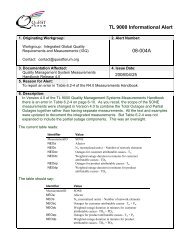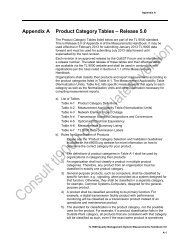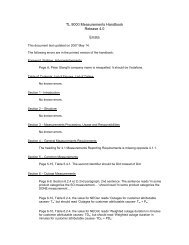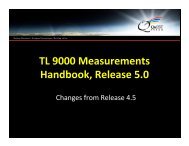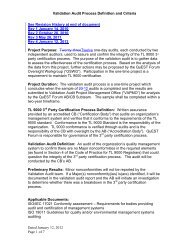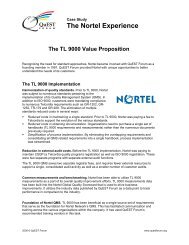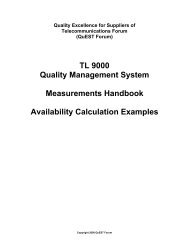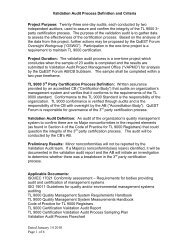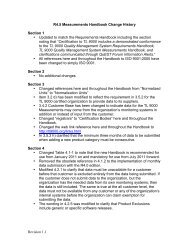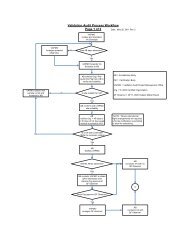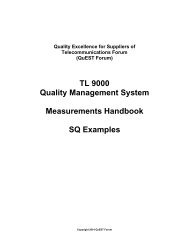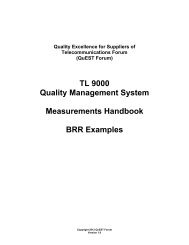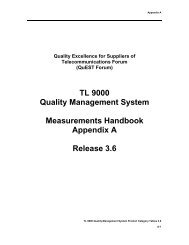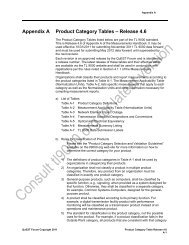ISO 9001/TL 9000 and CMMI® Comparison
ISO 9001/TL 9000 and CMMI® Comparison
ISO 9001/TL 9000 and CMMI® Comparison
You also want an ePaper? Increase the reach of your titles
YUMPU automatically turns print PDFs into web optimized ePapers that Google loves.
www.questforum.org<br />
<strong>ISO</strong> <strong>9001</strong>/<strong>TL</strong> <strong>9000</strong> <strong>and</strong><br />
<strong>CMMI®</strong> <strong>Comparison</strong><br />
Copyright QuEST Forum 2007 1
Purpose<br />
• This summary is intended to give those<br />
familiar with <strong>CMMI®</strong> a general sense of<br />
the additional requirements contained in<br />
<strong>TL</strong> <strong>9000</strong><br />
Copyright QuEST Forum 2007 2
Overview - 1<br />
• The <strong>TL</strong> <strong>9000</strong> st<strong>and</strong>ard adds specific<br />
telecom hardware, software <strong>and</strong> service<br />
requirements to the more generic<br />
practices specified by <strong>ISO</strong> <strong>9001</strong><br />
• The <strong>CMMI®</strong> model describes generic best<br />
practices for creating software systems in<br />
any domain.<br />
Copyright QuEST Forum 2007 3
Overview - 2<br />
• The <strong>TL</strong> <strong>9000</strong> st<strong>and</strong>ard contains specific<br />
detailed requirements<br />
• <strong>CMMI®</strong> "requires" that goals be met,<br />
"expects" that practices related to those<br />
goals are implemented, <strong>and</strong> provides<br />
suggestions for detailed implementation of<br />
the practices as informative, not required,<br />
material<br />
Copyright QuEST Forum 2007 4
Overview - 3<br />
• <strong>TL</strong> <strong>9000</strong> incorporates business needs as<br />
specific requirements<br />
• <strong>CMMI®</strong> says that all the process areas,<br />
goals, <strong>and</strong> practices must be interpreted<br />
based on business needs of the<br />
organization, but as a more generic model,<br />
does not include any explicit business<br />
needs<br />
Copyright QuEST Forum 2007 5
Overview - 4<br />
• <strong>TL</strong> <strong>9000</strong> is very strong in post-deployment<br />
requirements <strong>and</strong> measurements<br />
• <strong>CMMI®</strong> focuses primarily on predeployment<br />
best practices <strong>and</strong> in-process<br />
measurements<br />
Copyright QuEST Forum 2007 6
Overview - 5<br />
• <strong>TL</strong> <strong>9000</strong> gives specific instructions for<br />
customer involvement as stakeholders<br />
• <strong>CMMI®</strong> expects the organization to<br />
identify <strong>and</strong> involve relevant stakeholders,<br />
but does not specify who they should be<br />
Copyright QuEST Forum 2007 7
The Bottom Line<br />
• A <strong>CMMI®</strong> ML3 Appraised software organization<br />
will generally meet <strong>ISO</strong> <strong>9000</strong>/<strong>TL</strong> <strong>9000</strong><br />
requirements with gaps in the following areas:<br />
- Measurements Reporting<br />
- Post deployment support<br />
- Customer satisfaction surveys<br />
- Quality partnering<br />
• <strong>TL</strong> <strong>9000</strong> hardware (H) <strong>and</strong> service (V) adders<br />
are not specifically addressed in <strong>CMMI®</strong><br />
Copyright QuEST Forum 2007 8
<strong>TL</strong> <strong>9000</strong> St<strong>and</strong>ard – Not Present<br />
• This section includes four <strong>TL</strong> <strong>9000</strong> requirements<br />
that are not present in <strong>CMMI®</strong><br />
• Refer to the actual st<strong>and</strong>ards for full details of all<br />
requirements<br />
Copyright QuEST Forum 2007 9
<strong>TL</strong> <strong>9000</strong> St<strong>and</strong>ard – Not Present<br />
• 7.1.C.3 End of Life Planning<br />
– The organization shall establish <strong>and</strong> maintain a<br />
documented procedure(s) for the discontinuance of<br />
manufacturing <strong>and</strong>/or support of a product. The<br />
documented procedure(s) should include<br />
• a) cessation of full or partial support after a certain period of<br />
time,<br />
• b) archiving product documentation <strong>and</strong> software,<br />
• c) responsibility for any future residual support issues,<br />
• d) transition to the new product, if applicable, <strong>and</strong><br />
• e) accessibility of archive copies of data. [9]<br />
Copyright QuEST Forum 2007 10
<strong>TL</strong> <strong>9000</strong> St<strong>and</strong>ard – Not Present<br />
• 7.2.3.C.1 Notification About<br />
Problems<br />
– The organization shall establish <strong>and</strong> maintain<br />
a documented procedure(s) to notify all<br />
customers who may be affected by a reported<br />
problem that is service affecting. [5]<br />
Copyright QuEST Forum 2007 11
<strong>TL</strong> <strong>9000</strong> St<strong>and</strong>ard – Not Present<br />
• 7.2.3.C.2 Problem Severity<br />
– The organization shall assign severity levels to<br />
customer-reported problems based on the impact to<br />
the customer in accordance with the definitions of<br />
critical, major, <strong>and</strong> minor problem reports contained in<br />
the glossary of this h<strong>and</strong>book, unless explicitly<br />
excluded by the <strong>TL</strong> <strong>9000</strong> Measurements H<strong>and</strong>book.<br />
The severity level shall be used in determining the<br />
timeliness of the organization’s response. [10]<br />
– 7.2.3.C.2-NOTE The customer <strong>and</strong> the organization<br />
should jointly determine the priority for resolving<br />
customer-reported problems.<br />
Copyright QuEST Forum 2007 12
<strong>TL</strong> <strong>9000</strong> St<strong>and</strong>ard – Not Present<br />
• 7.2.3.HS.1 Organization’s Recall<br />
Process<br />
– The organization shall establish <strong>and</strong> maintain<br />
a documented procedure(s) for identifying <strong>and</strong><br />
recalling products that are unfit to remain in<br />
service.<br />
Copyright QuEST Forum 2007 13
<strong>ISO</strong>/<strong>TL</strong> <strong>9000</strong> St<strong>and</strong>ard<br />
- Partially Met<br />
• 78 Requirements that are partially met<br />
depending on the robustness of the <strong>CMMI®</strong><br />
implementation are listed in this section<br />
• Columns:<br />
– The Left <strong>and</strong> Middle columns are from the <strong>ISO</strong>/<strong>TL</strong><br />
st<strong>and</strong>ards. Blue text = <strong>ISO</strong>, Black = <strong>TL</strong> Adders<br />
– The <strong>ISO</strong>/<strong>TL</strong> verbiage is frequently NOT fully displayed<br />
to save space<br />
– The Right column has commentary <strong>and</strong> references<br />
CMMI abbreviations<br />
• Refer to the actual st<strong>and</strong>ards for full details of all<br />
requirements<br />
Copyright QuEST Forum 2007 14
<strong>ISO</strong>/<strong>TL</strong> <strong>9000</strong> St<strong>and</strong>ard- Partially Met<br />
Section 4 Quality Management System<br />
4.1.g Where an organization chooses to outsource any process that<br />
affects product conformity with requirements, …<br />
4.2.1 General<br />
4.2.1.a<br />
Section 4.2 Documentation Requirements<br />
The quality management system documentation shall include<br />
a) documented statements of a quality policy <strong>and</strong> quality<br />
objectives,<br />
Met by SAM with PP <strong>and</strong> IPM<br />
intent is met mostly in GP2.1 of each PA <strong>and</strong> SG1 of OPF.<br />
<strong>TL</strong> auditors expect to see a single org wide quality policy.<br />
4.2.1.b b) a quality manual, intent may be addressed in PAL in OPD <strong>and</strong> all GG2 but<br />
would be challenging to explain to <strong>TL</strong> auditor as a quality<br />
manual. Need to have an overall view of quality system.<br />
Section 5 Management Responsibility<br />
5.2 Customer Focus Top management shall ensure that customer requirements are<br />
determined <strong>and</strong> are met with the aim of enhancing customer<br />
satisfaction (see 7.2.1 <strong>and</strong> 8.2.1).<br />
5.2.C.1 Customer<br />
Relationship<br />
Development<br />
5.2.C.2 Customer<br />
Communication<br />
Procedures<br />
Top management shall demonstrate active involvement in<br />
establishing <strong>and</strong> maintaining mutually-beneficial relationships<br />
between the organization <strong>and</strong> its customers.<br />
The organization shall establish <strong>and</strong> maintain methods for<br />
communicating with selected customers... The outcome of<br />
customer communication should generate actions for resolving<br />
identified issues <strong>and</strong> provide opportunities for improving<br />
customer satisfaction.<br />
Specific implementation requirements for RD SG1 <strong>and</strong> SG3<br />
with GG2 of RD <strong>and</strong> all other PAs. <strong>TL</strong><strong>9000</strong> has very specific<br />
expectations re: top management involvement in customer<br />
satisfaction.<br />
Specific implementation requirements for RD SG1 <strong>and</strong> SG3<br />
with GG2 of RD <strong>and</strong> all other PA. <strong>TL</strong><strong>9000</strong> has very specific<br />
expectations re: top mgmt involvement in customer<br />
satisfaction.<br />
Specific implementation requirements for RD SG1 <strong>and</strong> SG3<br />
with GG2 of RD <strong>and</strong> all other PAs. <strong>TL</strong><strong>9000</strong> has very specific<br />
expectations re: top management involvement in customer<br />
satisfaction.<br />
Copyright QuEST Forum 2007 15
<strong>ISO</strong>/<strong>TL</strong> <strong>9000</strong> St<strong>and</strong>ard- Partially Met<br />
Section 5.4 Planning<br />
5.4.1 Quality Objectives Top management shall ensure that quality objectives, including<br />
those needed to meet requirements for product [see 7.1 a)], are<br />
established at relevant functions <strong>and</strong> levels within the<br />
organization...<br />
5.4.1.C.1 Quality<br />
Objectives<br />
5.4.2.C.2 Customer<br />
Input<br />
Objectives for quality shall include targets for the <strong>TL</strong> <strong>9000</strong><br />
measurements defined in the <strong>TL</strong> <strong>9000</strong> Quality Management<br />
System Measurements H<strong>and</strong>book.<br />
The organization shall implement methods for soliciting <strong>and</strong><br />
considering customer input for quality planning activities. The<br />
organization should establish joint quality improvement programs<br />
with customers.<br />
5.4.2.C.3 Supplier Input The organization shall implement methods for soliciting <strong>and</strong><br />
using supplier input for quality planning activities.<br />
5.5.2 Management<br />
Representative<br />
5.5.3 Internal<br />
Communication<br />
5.5.3.C.1 Organization<br />
Performance Feedback<br />
Section 5.5 Responsibility, Authority <strong>and</strong> Communication<br />
Top management shall appoint a member of management who,<br />
..., shall have responsibility <strong>and</strong> authority that includes…<br />
Top management shall ensure that appropriate communication<br />
processes are established within the organization <strong>and</strong> that<br />
communication takes place regarding the effectiveness of the<br />
quality management system.<br />
The organization shall inform employees of its quality<br />
performance <strong>and</strong> the level of customer satisfaction.<br />
At least partially met by OPF, OPD with GG2 for all PAs.<br />
Specific implementation requirements for MA SG1.<br />
Specific implementation requirements for GG3 <strong>and</strong> OPF<br />
with requirement to include customer input.<br />
Specific implementation requirements for GG3 of SAM <strong>and</strong><br />
OPF with requirement to include supplier input.<br />
Partially met by OPF GG2 <strong>and</strong> supported by GG2 of all<br />
other PAs (may have to explain to auditor how this is<br />
accomplished w/ 2.4 & 2.10). Specific implementation<br />
requirements for OPF GP2.4<br />
Specific requirement for implementation of GG2 all PA,<br />
particularly OPF.<br />
Specific implementation requirements for MA & OPF GP2.7<br />
<strong>and</strong> OPF SP1.2<br />
Copyright QuEST Forum 2007 16
<strong>ISO</strong>/<strong>TL</strong> <strong>9000</strong> St<strong>and</strong>ard- Partially Met<br />
Section 5.6 Management Review<br />
5.6.1 General Top management shall review the organization's quality<br />
management system, at planned intervals, ...<br />
Records from management reviews shall be maintained (see<br />
4.2.4).<br />
Partially addressed by GP 2.10 (PA/Project level) with OPF<br />
SG1<br />
5.6.2 Review Input The input to management review shall include information on… Partially addressed by GP 2.10 (PA/Project level) with OPF<br />
SG1 with input/outputs as specific requirements to GP2.10<br />
5.6.3 Review Output The output from the management review shall include any<br />
decisions <strong>and</strong> actions related to<br />
a) improvement of the effectiveness of the quality management<br />
system <strong>and</strong> its processes,<br />
b) improvement of product related to customer requirements, <strong>and</strong><br />
c) resource needs.<br />
6.1 Provision of<br />
Resources<br />
6.2.2.C.2 Quality <strong>and</strong><br />
Process Improvement<br />
Concepts<br />
Section 6 Resource Management<br />
b) to enhance customer satisfaction by meeting customer<br />
requirements.<br />
Those employees that have a direct impact on the quality of the<br />
product, including top management, shall be trained in the<br />
fundamental concepts of continual improvement, problem<br />
solving, <strong>and</strong> customer satisfaction.<br />
6.2.2.C.4 ESD Training All employees with functions that involve any h<strong>and</strong>ling, storage,<br />
packaging, preservation, or delivery of ESD-sensitive products<br />
shall receive training in electrostatic discharge (ESD) protection<br />
prior to performing their jobs.<br />
6.2.2.C.6 Hazardous<br />
Conditions Training<br />
Content<br />
Where the potential for hazardous conditions exists, training<br />
content shall include…<br />
6.3.C.1 Infrastructure The organization shall identify critical areas of the infrastructure<br />
<strong>and</strong> provide for the security needed to protect these areas.<br />
Security restoration plans shall be developed <strong>and</strong> periodically<br />
assessed.<br />
Partially addressed by GP 2.10 (PA/Project level) with OPF<br />
SG1 with input/outputs as Specific implementation<br />
requirements for GP2.10<br />
Partially met by GG2 for all PAs particularly RD. <strong>TL</strong> <strong>9000</strong><br />
expects some indication of how customer satisfaction is<br />
enhanced by the resources provided for the quality<br />
management system.<br />
Specific implementation requirements for GP2.5 of all PAs -<br />
includes training in fundamental quality concepts.<br />
Specific implementation requirements for OT SG1 <strong>and</strong> PP<br />
SP2.5<br />
Specific implementation requirements for OT SG1 <strong>and</strong> PP<br />
SP2.5 (see OHSHA & Safety department for your own<br />
implementation)<br />
Partially met by PP SG2 (SP2.3) <strong>and</strong> PMC SP1.4 which<br />
address security within the data management practices but<br />
do not directly address security restoration plans.<br />
Copyright QuEST Forum 2007 17
<strong>ISO</strong>/<strong>TL</strong> <strong>9000</strong> St<strong>and</strong>ard- Partially Met<br />
Section 7 Product Realization<br />
7.1.C.1 Life Cycle Model The organization shall establish <strong>and</strong> maintain an integrated set of<br />
method(s) that covers the life cycle of its products. The<br />
method(s) shall contain, as appropriate, the processes, activities,<br />
<strong>and</strong> tasks involved in the concept, definition, development,<br />
introduction, production, operation, maintenance, <strong>and</strong> (if<br />
required) disposal of products, spanning the life of the products.<br />
7.1.C.2 Disaster<br />
Recovery<br />
7.1.C.4 Tools<br />
Management<br />
The organization shall establish <strong>and</strong> maintain documented plans<br />
for disaster recovery to ensure the organization’s ability to<br />
recreate <strong>and</strong> service the product throughout its life cycle.<br />
The organization shall ensure that internally developed software<br />
<strong>and</strong>/or tools used in the product life cycle are subject to the<br />
appropriate quality method(s).<br />
OPD specifies process architecture, PP & IPM plus GG2 of<br />
all PAs plan for how it's all put together for a project. CMMI<br />
does not specify methods for end of life part of life cycle, but<br />
IPM says processes must be defined for entire product<br />
lifecycle.<br />
Specific implementation requirements - CMMI does not<br />
directly address disaster recovery however risk mitigation<br />
practices (RSKM, CM, RD, TS practices can be applied to<br />
address disaster recovery)<br />
Not fully met but supported by GG2 for the engineering PAs;<br />
Specific implementation requirements for management of<br />
the development & test environment tools beyond what<br />
CMMI requires.<br />
Copyright QuEST Forum 2007 18
7.2.2.C.2 Contract<br />
Review<br />
7.2.3 Customer<br />
Communication<br />
7.2.3.C.3 Problem<br />
Escalation<br />
7.2.3.C.4 Customer<br />
Feedback<br />
7.2.3.HS.2 Design <strong>and</strong><br />
Development Process<br />
Quality Measurements<br />
Data Reporting<br />
<strong>ISO</strong>/<strong>TL</strong> <strong>9000</strong> St<strong>and</strong>ard- Partially Met<br />
Section 7.2 Customer-related Processes<br />
The organization shall establish <strong>and</strong> maintain a contract review<br />
process that should include…<br />
The organization shall determine <strong>and</strong> implement effective<br />
arrangements for communicating with customers in relation to…<br />
The organization shall establish <strong>and</strong> maintain a documented<br />
escalation procedure(s) to resolve customer-reported problems.<br />
The organization shall provide the customer with feedback on<br />
their problem reports in a timely <strong>and</strong> systematic manner.<br />
On request by the customer, communications shall include<br />
reporting <strong>and</strong> evaluation of a jointly agreed set of design <strong>and</strong><br />
development process measurements.<br />
CMMI does not specify a contract review process (except<br />
for contracts with suppliers) but majority (not incl item c) of<br />
these activities are supported by CMMI practices in all PAs.<br />
Supplier contract review is met by SAM SG1.<br />
CMMI does not have a customer communication process<br />
but this is supported by GP2.7 in many of the Pas<br />
CMMI does not specify a customer communication process<br />
but this is supported by GP2.7 in many of the Pas<br />
CMMI does not specify a customer communication process<br />
but this is supported by GP2.7 in many of the Pas<br />
Specific implementation requirements for MA <strong>and</strong> PP, PMC<br />
Copyright QuEST Forum 2007 19
7.3.1.HS.1 Migration<br />
Planning<br />
<strong>ISO</strong>/<strong>TL</strong> <strong>9000</strong> St<strong>and</strong>ard- Partially Met<br />
Section 7.3 Design <strong>and</strong> Development<br />
The organization shall develop <strong>and</strong> document a migration plan<br />
when a system, hardware or software product is planned to be<br />
migrated from an old to a new operational environment. If the old<br />
environment will no longer be supported, users shall be given …<br />
Specific implementation requirements for OPD SG1 <strong>and</strong> the<br />
engineering PAs. CMMI model expects that post<br />
deployment needs will be addressed as a part of planning &<br />
development but does not specify how those needs will be<br />
met.<br />
7.3.1.HS.1.a The migration plan should also include... Specific implementation requirements for OPD SG1 <strong>and</strong> the<br />
engineering PAs. CMMI model expects that post<br />
deployment needs will be addressed as a part of planning &<br />
development but does not specify how those needs will be<br />
met.<br />
7.3.1.S.3 Computer<br />
Resources<br />
7.3.2.C.1 Customer <strong>and</strong><br />
Supplier Input<br />
7.3.2.C.2 Design <strong>and</strong><br />
Development<br />
Requirements<br />
The organization shall establish <strong>and</strong> maintain methods for<br />
estimating <strong>and</strong> tracking critical computer resources for the target<br />
computer, the computer on which the software is intended to<br />
operate.<br />
The organization shall establish <strong>and</strong> maintain methods for<br />
soliciting <strong>and</strong> using customer <strong>and</strong> supplier input during the<br />
development of new or revised product requirements.<br />
Design <strong>and</strong> development requirements shall be defined <strong>and</strong><br />
documented, <strong>and</strong> should include…<br />
Specific implementation requirements for GG2 of the<br />
engineering practices.<br />
Specific implementation requirements for stakeholder<br />
involvement in RD <strong>and</strong> REQM <strong>and</strong> IPM SG2<br />
Specific implementation requirements for RD <strong>and</strong> REQM<br />
<strong>and</strong> VAL SG1.<br />
Copyright QuEST Forum 2007 20
7.3.3 Design <strong>and</strong><br />
Development Outputs<br />
7.3.3.V.1 Services<br />
Design <strong>and</strong><br />
Development Output<br />
7.3.5.C.1 Verification of<br />
Documentation<br />
7.3.5.HS.1 Stress<br />
Testing<br />
7.3.5.HS.2 Abnormal<br />
Conditions<br />
7.3.6.S.1 Release<br />
Management<br />
7.3.7.C.2 Informing<br />
Customers<br />
7.3.7.C.3 Problem<br />
Resolution<br />
Configuration<br />
Management<br />
7.3.7.H.1 Component<br />
Changes<br />
<strong>ISO</strong>/<strong>TL</strong> <strong>9000</strong> St<strong>and</strong>ard- Partially Met<br />
The outputs of design <strong>and</strong> development shall be provided in a<br />
form that enables verification against the design <strong>and</strong><br />
development input <strong>and</strong> shall be approved prior to release.<br />
Design <strong>and</strong> development outputs shall...<br />
The required output from the services design <strong>and</strong> development<br />
shall contain a complete <strong>and</strong> precise statement of the service to<br />
be provided. Design <strong>and</strong> development outputs shall include…<br />
The organization shall verify the customer <strong>and</strong>/or user<br />
documentation prior to product delivery.<br />
The organization shall test the product under stress conditions,<br />
including, but not limited to, out-of-boundary <strong>and</strong> invalid input<br />
conditions, high volume <strong>and</strong> peak load simulations, <strong>and</strong><br />
operational errors.<br />
The organization shall test the product under abnormal<br />
conditions, which shall include, as appropriate...<br />
The organization shall establish <strong>and</strong> maintain method(s) to<br />
ensure that the release <strong>and</strong> delivery of software products <strong>and</strong><br />
related documentation are carried out under controlled<br />
conditions.<br />
Method(s) should provide for the delivery to the customer of ...<br />
The organization shall establish <strong>and</strong> maintain a documented<br />
procedure(s) to ensure that customers are informed when design<br />
changes affect contractual commitments.<br />
The organization shall ensure that its configuration management<br />
system tracks fixes to problems <strong>and</strong> incorporates those fixes in<br />
future revisions.<br />
The organization shall have a documented procedure(s) in place<br />
to ensure that material or component substitutions or changes do<br />
not adversely affect product quality or performance. The<br />
documented procedure(s) should include…<br />
Specific implementation requirements for Technical<br />
Package in TS SG2<br />
Specific implementation requirements for developing<br />
technical solution when product is a service in V1.1.. In<br />
V1.2 it will be met by services constellation.<br />
Specific implementation requirements for VER SG1 <strong>and</strong><br />
SG3, as well as VAL SG1 <strong>and</strong> SG2<br />
Specific implementation requirements for VAL SG1 <strong>and</strong><br />
SG2. Might also show up in VER<br />
Specific implementation requirements for VAL SG1 <strong>and</strong><br />
SG2. Might also show up in VER<br />
Specific implementation requirements for PI SG3 <strong>and</strong><br />
supported by CM SG1, SG2 <strong>and</strong> SG3.<br />
Specific implementation requirements for REQM SG1 <strong>and</strong><br />
GG2<br />
Specific implementation requirements for CM to include<br />
fixes from patches <strong>and</strong> dot releases in future releases of the<br />
code<br />
Specific implementation requirements for TS SG1 <strong>and</strong> SAM<br />
SG1 <strong>and</strong> SG2<br />
Copyright QuEST Forum 2007 21
7.4.1.C.1 Purchasing<br />
Procedure(s)<br />
7.4.2 Purchasing<br />
Information<br />
7.5.1 Control of<br />
Production <strong>and</strong> Service<br />
Provision<br />
7.5.1.C.1 Service<br />
Resources<br />
7.5.1.C.2 Product<br />
Delivery<br />
7.5.1.HS.1 Emergency<br />
Service<br />
<strong>ISO</strong>/<strong>TL</strong> <strong>9000</strong> St<strong>and</strong>ard- Partially Met<br />
Section 7.4 Purchasing<br />
The organization shall establish <strong>and</strong> maintain a documented<br />
purchasing procedure(s) to ensure…<br />
Purchasing information shall describe the product to be<br />
purchased, including where appropriate...B57<br />
Section 7.5 Production <strong>and</strong> Service Provision<br />
The organization shall plan <strong>and</strong> carry out production <strong>and</strong> service<br />
provision under controlled conditions. Controlled conditions shall<br />
include, as applicable…<br />
The organization shall provide customer contact employees with<br />
appropriate tools, training, <strong>and</strong> resources necessary to provide<br />
effective <strong>and</strong> timely customer service.<br />
The organization shall establish <strong>and</strong> maintain method(s) to<br />
minimize interference with the customer’s normal site operation<br />
<strong>and</strong> service during product delivery <strong>and</strong> installation.<br />
The organization shall ensure that services <strong>and</strong> resources are<br />
available to support recovery from emergency failures of product<br />
in the field throughout its expected life. The organization shall<br />
identify potential situations that may have an impact on its ability<br />
to provide the emergency service <strong>and</strong> shall have response plans<br />
to address these situations. These plans shall be based on risk<br />
<strong>and</strong> periodically assessed.<br />
Specific implementation requirements for SAM SG1 <strong>and</strong><br />
SG2, as well as GG2 <strong>and</strong> GG3<br />
Specific implementation requirements for MA SG1<br />
Specific implementation requirements for IPI SG 1 <strong>and</strong><br />
SG2<br />
Specific implementation requirements for PP SG1 <strong>and</strong> SG2<br />
as well as OPD SG 1 <strong>and</strong> IPM SG1.<br />
Specific implementation requirements for PI SG1 <strong>and</strong> SG3,<br />
as well as TS SG1 <strong>and</strong> RD SG1 <strong>and</strong> SG3<br />
Specific implementation requirements - services related to<br />
the product will be implemented via specific <strong>and</strong> generic<br />
practices of PP, RSKM <strong>and</strong> all the engineering PAs<br />
Copyright QuEST Forum 2007 22
7.5.1.HV.1 Operational<br />
Changes<br />
7.5.1.S.1 Patching<br />
Procedure(s)<br />
7.5.1.S.2 Patch<br />
Documentation<br />
<strong>ISO</strong>/<strong>TL</strong> <strong>9000</strong> St<strong>and</strong>ard- Partially Met<br />
Each time a significant change is made in the established<br />
operation (e.g., a new operator, new machine, or new technique),<br />
a critical examination shall be made of the first unit(s)/service(s)<br />
processed after the change.<br />
The organization shall establish <strong>and</strong> maintain a documented<br />
patching procedure(s) that…<br />
The organization shall establish <strong>and</strong> maintain methods to ensure<br />
that all documentation required to describe, test, install, <strong>and</strong><br />
apply a patch has been verified <strong>and</strong> delivered with the patch.<br />
7.5.1.S.3 Replication The organization shall establish <strong>and</strong> maintain a documented<br />
procedure(s) for replication, which should include…<br />
7.5.1.V.1 Software Used<br />
in Service Delivery<br />
Organizations shall document <strong>and</strong> implement processes for the<br />
maintenance <strong>and</strong> control of software used in service delivery to<br />
ensure continued process capability <strong>and</strong> integrity.<br />
7.5.1.V.2 Tool Changes The organization shall have a documented procedure(s) in place<br />
to ensure that substitutions or changes to tools used in<br />
performing the service do not adversely affect the quality of the<br />
service.<br />
Specific implementation requirements for VER SG1 <strong>and</strong><br />
SG3 <strong>and</strong> VAL SG1 <strong>and</strong> SG2<br />
Specific implementation requirement for PI<br />
Specific implementation requirement for PI<br />
Specific implementation requirements for PI SG3 <strong>and</strong> for<br />
CM SG1, SG2 & SG3<br />
Specific implementation requirements for IPM SG1 <strong>and</strong><br />
OPD SG1 <strong>and</strong> PI GG2; may be better supported by services<br />
constellation.<br />
Specific implementation requirements for IPM SG1 <strong>and</strong><br />
OPD SG1 <strong>and</strong> PI GG2; may be better supported by CMMI-<br />
SVC (services) constellation.<br />
Copyright QuEST Forum 2007 23
7.5.2 Validation of<br />
processes for<br />
production <strong>and</strong> service<br />
provision<br />
7.5.4 Customer<br />
Property<br />
7.5.5 Preservation of<br />
Product<br />
7.5.5.C.1 Electrostatic<br />
Discharge Sensitive<br />
(ESDS) Protection<br />
7.5.5.HS.1 Packaging<br />
<strong>and</strong> Labeling<br />
Verification<br />
<strong>ISO</strong>/<strong>TL</strong> <strong>9000</strong> St<strong>and</strong>ard- Partially Met<br />
The organization shall validate any processes for production <strong>and</strong><br />
service provision where the resulting output cannot be verified by<br />
subsequent monitoring or measurement. This includes any<br />
processes where deficiencies become apparent only after the<br />
product is in use or the service has been delivered.<br />
Validation shall demonstrate...<br />
The organization shall exercise care with customer property<br />
while it is under the organization's control or being used by the<br />
organization...<br />
The organization shall preserve the conformity of product during<br />
internal processing <strong>and</strong> delivery to the intended destination. This<br />
preservation shall include identification, h<strong>and</strong>ling, packaging,<br />
storage <strong>and</strong> protection…<br />
Where applicable, anti-static protection shall be employed for<br />
components <strong>and</strong> products susceptible to electrostatic discharge<br />
(ESD) damage.<br />
The organization shall establish <strong>and</strong> maintain methods to ensure<br />
that the packaging <strong>and</strong> labeling of products <strong>and</strong> components<br />
conform to specified requirements.<br />
Specific implementation requirements for VAL SG1 & SG2,<br />
PPQA SG1 & SG2 <strong>and</strong> OPF SG1 may be better supported<br />
by CMMI-SVC (services) constellation.<br />
Specific implementation requirement for PP SG2 <strong>and</strong><br />
supported by CM.<br />
Specific implementation requirement for PI related to<br />
shipping & h<strong>and</strong>ling.<br />
Strong HW related implementation requirement for IPM<br />
SG1, PI, CM, OPF, OPD SG1<br />
Specific implementation requirements for PI SG3<br />
Copyright QuEST Forum 2007 24
<strong>ISO</strong>/<strong>TL</strong> <strong>9000</strong> St<strong>and</strong>ard- Partially Met<br />
7.5.5.H.1 Deterioration Where the possibility of deterioration exists, the organization<br />
shall establish <strong>and</strong> maintain methods to determine when<br />
materials that may impact product quality have deteriorated or<br />
exceeded their expiration dates, <strong>and</strong> assess any required<br />
subsequent action.<br />
7.5.5.S.1 Software Virus<br />
Protection<br />
7.6 Control of<br />
Monitoring <strong>and</strong><br />
Measuring Devices<br />
The organization shall establish <strong>and</strong> maintain methods for<br />
software virus prevention, detection, <strong>and</strong> removal from the<br />
deliverable product.<br />
The organization shall determine the monitoring <strong>and</strong><br />
measurement to be undertaken <strong>and</strong> the monitoring <strong>and</strong><br />
measuring devices...<br />
7.6.a Where necessary to ensure valid results, measuring equipment<br />
shall<br />
a) be calibrated …<br />
7.6.C.1 Equipment<br />
Identification<br />
Monitoring <strong>and</strong> measuring devices that are either inactive or<br />
unsuitable for use shall be visibly identified <strong>and</strong> not used. All<br />
monitoring <strong>and</strong> measuring devices that do not require calibration<br />
shall be identified.<br />
Specific implementation requirement for PI related to<br />
hardware storage.<br />
Specific implementation requirements for RD <strong>and</strong> other<br />
engineering process areas<br />
Specific implementation requirements for IPM SG1 & GG2,<br />
VER SG1<strong>and</strong> all other engineering Pas<br />
Specific implementation requirements for IPM SG1 & GG2,<br />
VER SG1<strong>and</strong> all other engineering Pas<br />
Specific implementation requirements for IPM SG1 & GG2,<br />
VER SG1<strong>and</strong> all other engineering Pas<br />
Copyright QuEST Forum 2007 25
8.2.1 Customer<br />
Satisfaction<br />
8.2.1.C.1 Customer<br />
Satisfaction Data<br />
<strong>ISO</strong>/<strong>TL</strong> <strong>9000</strong> St<strong>and</strong>ard- Partially Met<br />
Section 8 Measurement, Analysis <strong>and</strong> Improvement<br />
As one of the measurements of the performance of the quality<br />
management system, the organization shall monitor information<br />
relating to customer perception as to whether the organization<br />
has met customer requirements…<br />
The organization shall establish <strong>and</strong> maintain a method to collect<br />
data directly from customers concerning their satisfaction...<br />
8.2.2 Internal Audit The organization shall conduct internal audits at planned<br />
intervals...<br />
8.2.4.H.1 Periodic<br />
Retesting<br />
8.2.4.H.2 Content of<br />
Testing<br />
8.2.4.H.3 Frequency of<br />
Testing<br />
8.2.4.H.4-Testing of<br />
Repair <strong>and</strong> Return<br />
Products<br />
The organization shall establish <strong>and</strong> maintain a documented<br />
procedure(s) that ensures products are periodically retested...<br />
Content of Testing – The initial test <strong>and</strong> periodic retest shall be<br />
more extensive than the routine quality tests...<br />
The organization shall establish <strong>and</strong> document the frequency for<br />
test <strong>and</strong> periodic retest...<br />
Repair <strong>and</strong> return products shall be subjected to the appropriate<br />
evaluation(s) <strong>and</strong>/or test(s) to ensure functionality to product<br />
specification.<br />
Specific implementation requirements for MA<br />
Specific implementation requirements for MA<br />
Specific implementation requirements for OPF SG1 <strong>and</strong><br />
PPQA SG1<br />
Hardware implementation requirement related to REQM<br />
SG1 <strong>and</strong> VER SG1 <strong>and</strong> SG3<br />
Hardware implementation requirement related to REQM<br />
SG1, VER (SG1, SG3) <strong>and</strong> VAL (SG1, SG2).<br />
Hardware implementation requirement related to REQM<br />
SG1 <strong>and</strong> VER SG1 <strong>and</strong> SG3<br />
Specific implementation requirement for VER <strong>and</strong> VAL of<br />
hardware product that is being repaired <strong>and</strong> returned.<br />
Copyright QuEST Forum 2007 26
8.2.4.HV.1 Inspection<br />
<strong>and</strong> Test<br />
Documentation<br />
8.2.4.HV.2 Inspection<br />
<strong>and</strong> Test Records<br />
<strong>ISO</strong>/<strong>TL</strong> <strong>9000</strong> St<strong>and</strong>ard- Partially Met<br />
Each inspection or testing activity shall have detailed<br />
documentation. Details should include…<br />
Specific implementation requirement for VER <strong>and</strong> VAL of<br />
hardware <strong>and</strong> services<br />
Inspection or test records shall include… Specific implementation requirement for VER <strong>and</strong> VAL of<br />
hardware <strong>and</strong> services<br />
8.4.a a) customer satisfaction (see 8.2.1), Specific implementation requirement for all of the above<br />
8.4.d d) suppliers. Specific implementation requirement for GG2 <strong>and</strong> GG3 of<br />
SAM<br />
8.4.H.1 Field<br />
Performance Data<br />
8.4.V.1 Service<br />
Performance Data<br />
The quality management system shall include the collection <strong>and</strong><br />
analysis of field performance data which can be used to help<br />
identify the cause <strong>and</strong> frequency of product failure. In addition,<br />
no trouble found (NTF) data shall also be maintained. This<br />
information shall be provided to the appropriate organizations to<br />
foster continual improvement.<br />
The quality management system shall include the collection <strong>and</strong><br />
analysis of service performance data, which can be used to<br />
identify the cause <strong>and</strong> frequency of service failure. This<br />
information shall be provided to the appropriate organizations to<br />
foster continual improvement of the service.<br />
Specific implementation requirement for HW post<br />
deployment metrics in MA SG1 & SG2 <strong>and</strong> PI GG3.<br />
Specific implementation requirement for services post<br />
deployment metrics in MA SG1 & SG2 <strong>and</strong> PI GG3.<br />
Copyright QuEST Forum 2007 27
Copyright QuEST Forum 2007 28



